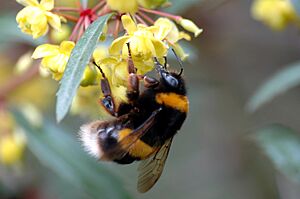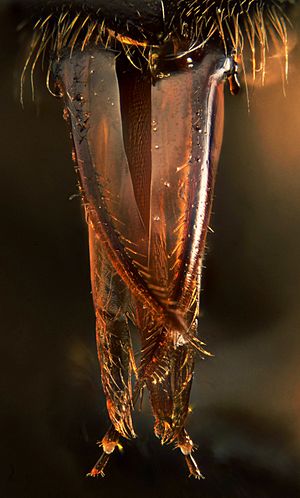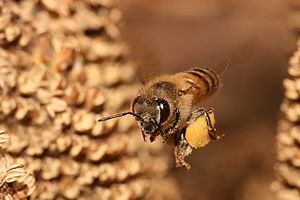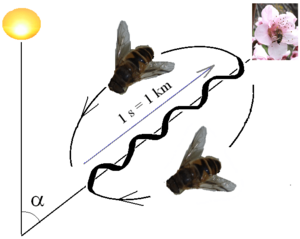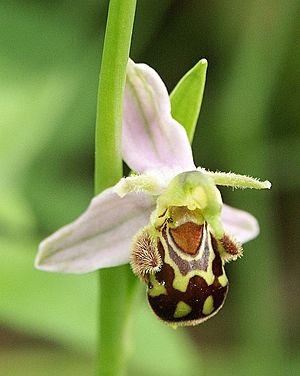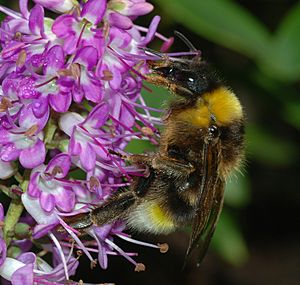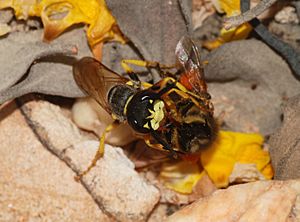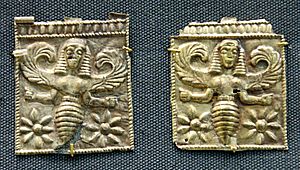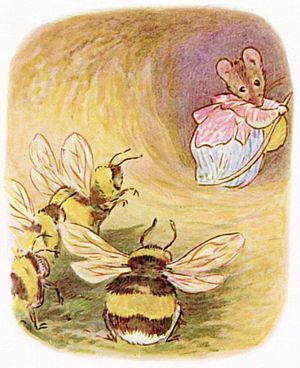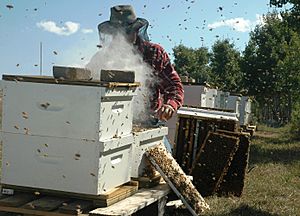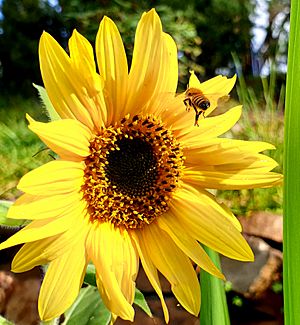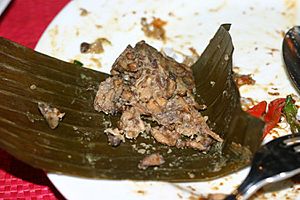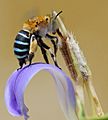Bee facts for kids
Quick facts for kids Bees |
|
|---|---|
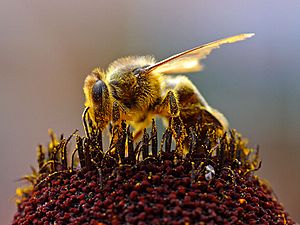 |
|
| A honey bee | |
| Scientific classification | |
| Kingdom: | |
| Phylum: | |
| Class: | |
| Order: | |
| Suborder: | |
| Superfamily: |
Apoidea
|
Bees are flying insects. They belong to the same group as ants and wasps. There are about 20,000 different species of bees. Bees collect pollen from flowers. You can find bees on every continent except Antarctica.
Bees are usually grouped into four main types:
- Honeybees, like the Africanized honeybee.
- Bumblebees.
- Stingless bees.
- Solitary bees.
The European honey bee (called Apis mellifera by biologists) is famous. Humans keep these bees to get honey. Keeping bees for honey is known as beekeeping. It is also called apiculture.
Contents
How Bees Evolved
Long ago, beetles and other insects pollinated the first flowers. Bees came much later. Bees are special because they are very good at pollination. They have changed their bodies and behaviors to make it easier. Bees are better at this job than many other insects. Scientists believe bees helped flowering plants spread. In turn, these plants helped bees evolve even more.
Bees are a special kind of wasp. Their ancestors were wasps that hunted other insects. Bees likely started eating pollen when they caught prey covered in it. This change from hunting to collecting pollen happened over a long time.
Scientists found a very old bee fossil. It is about 100 million years old! This fossil shows it was a bee that collected pollen. But it still had some old wasp features. Scientists are still learning about how bee families are related.
What Bees Look Like
It is usually easy to tell if an insect is a bee. Bees have fuzzy, branched hairs called setae. They also have special combs on their front legs. These combs help them clean their antennae. Female bees have a split plate on their abdomen. These features help tell them apart from wasps.
One main thing bees do is collect pollen. They use it to feed their young. Bees have special body parts to help them do this. Some wasps also collect pollen. A few bee species even eat meat from dead animals.
The biggest bee is the Indonesian resin bee. It is called Megachile pluto. Female bees can be about 39 millimeters (1.5 inches) long. The smallest bees are tiny stingless bees. They are less than 2 millimeters (0.08 inches) long.
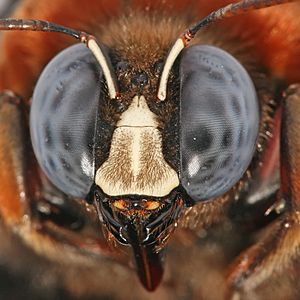
A bee has two large compound eyes. These cover most of its head. Bees also have three small simple eyes called ocelli. These eyes help them sense light and dark. Bees' antennae have many parts. They help bees feel, smell, and taste. They can also sense air movement to "hear" sounds. Bees' mouthparts are made for both chewing and sucking. They have strong jaws called mandibles. They also have a long proboscis to suck up nectar.
A bee's body has three main parts. The middle part is the thorax. It has three segments. Each segment has a pair of strong legs. The back two segments have a pair of clear wings. Many bees have pollen baskets on their back legs. These are flat areas with hairs to hold pollen. The front and back wings hook together when the bee flies. The abdomen is the last part. It has nine segments. The last three segments form the sting.
Bee Communities
How Bees Live Together
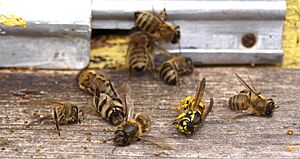
Bees can live alone or in groups. Some bees live in very organized groups called eusocial colonies. These colonies have special features. They work together to care for their young. Adults have different jobs, like reproducing or working. Also, different generations live together. This creates special groups called castes.
In some species, female bees live together. If they have different jobs, they are called semisocial. If the group has a mother (the queen) and her daughters (workers), it is eusocial. If the jobs are just different behaviors, it is primitively eusocial. If the bees look very different based on their jobs, it is highly eusocial.
True honey bees (genus Apis) are highly eusocial. They are some of the most well-known insects. Their colonies start when a queen and many workers leave the old hive. This is called swarming. There are many types of Apis mellifera. These bees are from Europe, the Middle East, and Africa. Africanized bees are a mix of European and African bees. They are very protective of their hives.
Stingless bees are also highly eusocial. They build complex nests. Their colonies last a long time. They also start new colonies by swarming.
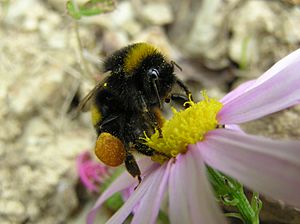
Many bumblebees are eusocial. A queen bumblebee starts a nest by herself. Bumblebee colonies usually have 50 to 200 bees. They are largest in summer. Their nests are simple. Colonies usually last less than a year. Groups like the International Union for Conservation of Nature are checking how many bumblebee species are at risk.
Many bees are primitively eusocial. These bees are often in the family Halictidae, known as "sweat bees." Their colonies are small, usually with fewer than a dozen workers. Queens and workers look similar. Most colonies last only one season. Only mated females survive winter. Some species can be eusocial in one area and solitary in another.
Solitary and Communal Bees

Most other bees live alone. These include carpenter bees, leafcutter bees, and mason bees. Each female bee can lay eggs. She builds her own nest. There are no queens or worker bees in these species. Solitary bees usually do not make honey or beeswax.
Solitary bees are very important for pollination. They collect pollen to feed their young. They often mix pollen with nectar to make a paste. Some solitary bees have special body parts to carry pollen. A few types of solitary bees are raised to pollinate crops. These include carpenter bees, sweat bees, mason bees, and digger bees.
Most solitary bees nest in the ground. They like different types of soil. Others build nests in hollow reeds, twigs, or holes in wood. The female bee makes a small room, called a "cell." She puts an egg and food for the larva inside. Then she seals it. A nest can have many cells. The male bees usually hatch first. They are ready to mate when the females appear. Solitary bees rarely sting. They only sting if they feel very threatened.
Some solitary bees like to nest close to each other. This makes it look like they are social. These groups are called "aggregations." They are different from colonies. In some species, many females share one nest entrance. But each female builds and cares for her own cells. This is called a "communal" group. Sharing an entrance helps protect the nest from predators.
Bee Life Cycle
A bee's life starts as an egg. Then it becomes a legless larva. The larva grows and sheds its skin several times. Next, it becomes a pupa. During this stage, it changes completely into an adult bee. Finally, a winged adult bee comes out.
Most solitary bees and bumble bees in cold places spend winter as adults or pupae. They come out in spring when flowers bloom. Males usually appear first. They look for females to mate with. The sex of a bee depends on the egg. Fertilized eggs become females. Unfertilized eggs become males. Tropical bees can have many generations in a year.
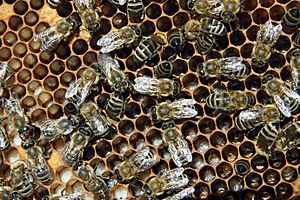
Bee eggs are usually long and slightly curved. For solitary bees, each egg is laid in a cell with a supply of pollen and nectar. This food is called mass provisioning. Social bees feed their larvae regularly as they grow. This is called progressive provisioning. Nests can be simple holes in the ground or wood. Or they can be large structures with wax combs, like for bumblebees and honey bees.
Bee larvae are whitish grubs. They are oval-shaped. They have segments and holes for breathing. They do not have legs. But they can move inside their cell. They have small jaws for eating. They also have a gland that makes silk. They use this silk to build their cocoons.
The pupa can be seen through the cocoon. Over a few days, it changes into an adult bee. When it is ready, it breaks out of the cocoon and the cell.
How Bees Fly
For a long time, people thought bee flight was a mystery. Scientists once said that bees "shouldn't be able to fly." This was based on old calculations. But bees do not fly like airplanes. They fly more like helicopters. In 1996, scientists showed how. Bees create swirling air currents with their wings. These currents help them get lift.
High-speed cameras showed how bees fly. They use short, quick wing strokes. They also quickly twist their wings as they change direction. Bees flap their wings about 230 times per second. This is very fast!
Finding Food and Talking
A scientist named Karl von Frisch studied how honey bees find their way. He found that honey bees communicate using a special "waggle dance." A worker bee does this dance in the hive. It tells other bees where to find food.
He showed that bees can find directions in three ways. They use the sun, the pattern of light in the sky, and the Earth’s magnetic field. The sun is their main guide. They use the other ways when it is cloudy or inside the dark hive. Bees remember places like a map.
Bees in Nature
Flowers and Bees
Most bees collect pollen from many different kinds of flowers. These are called generalists. But some bees are specialists. They only collect pollen from one or a few types of plants. Some specialist bees collect flower oils instead of pollen. Male orchid bees collect scents from orchids.
Bees find flowers in many ways. They can see special patterns on flowers using ultraviolet light. They can also smell flowers. Bees can even sense electric fields around flowers. Once they land, they taste the nectar and pollen. This helps them decide if they want to keep visiting similar flowers.
Sometimes, a plant needs only one type of bee to pollinate it. If that bee is in danger, the plant might be too. However, specialist bees often visit common plants. These plants are also visited by many other pollinators. For example, about 40 types of specialist bees visit the Creosote bush in the southwestern United States.
Bees as Look-Alikes
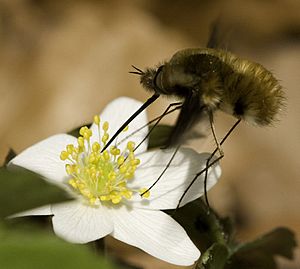
Many bees have bright colors, like orange and black. These colors warn others that they can sting. This is called warning coloration. Other harmless insects copy these colors to protect themselves. For example, bee-flies and hoverflies look like bees. This is called Batesian mimicry. They trick predators into thinking they can sting.
Bees also look like other stinging insects, like wasps. This is called Müllerian mimicry. All these insects benefit from having the same warning colors. Predators learn to avoid them more quickly.
Some plants also trick bees. The bee orchid looks and smells like a female bee. Male bees try to mate with the flower. This helps the flower get pollinated.
Bees That Are Parasites
Some bees are brood parasites. This means they lay their eggs in other bees' nests. These bees do not have pollen-collecting parts. They do not build their own nests. They go into another bee's nest and lay an egg. When the parasite larva hatches, it eats the host bee's food. It often eats the host egg too. For example, the Arctic bee Bombus hyperboreus attacks and takes over other bumblebee nests.
In South Africa, some Cape honeybees are destroying other honeybee hives. These parasitic bees lay special eggs. This leads to the colony's destruction. Then the parasites move to other hives.
Bombus subgenus Psithyrus bees are cuckoo bees. They look like the bumblebees they parasitize. Other cuckoo bees parasitize bees from different families.
Bees That Fly at Night
Some bees are active at dawn, dusk, or night. Most of these bees live in warm places. But some live in dry, colder areas. These bees have very large ocelli (simple eyes). These eyes are very sensitive to light and dark. But they cannot form clear images. Some have special compound eyes that gather a lot of light. Flying at night helps them avoid predators. It also lets them find flowers that open only at night.
Bee Predators and Dangers
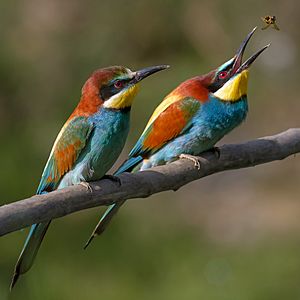
Many animals hunt bees. Birds like bee-eaters and flycatchers catch bees in the air. Honey buzzards dig up bee nests to eat the larvae. The greater honeyguide bird leads humans to wild bee nests. Humans open the nests for honey, and the bird eats the larvae and wax. Mammals like badgers also dig up bumblebee nests. They eat the larvae and stored food.
Other insects also hunt bees. Crab spiders wait on flowers to ambush bees. Praying mantises also hide and catch bees. Beewolves are large wasps that hunt bees. One beewolf colony can kill thousands of honeybees in a day. Robber flies and dragonflies also sometimes catch bees.
Honey bees can get sick from parasites. These include tiny mites like Varroa mites. However, some bees and mites might help each other.
Bees and People
Bees in Stories and History
Ancient Greek stories talk about three bee maidens. They could tell the future. Honey was seen as the food of the gods. A Greek myth says a nymph named Melissa (meaning "Bee") found honey. Bees were also linked to the Oracle of Delphi. The prophetess there was sometimes called a bee.
People have used the idea of a bee community for a long time. Thinkers like Aristotle and Plato used it as a model for human society. In English folklore, people would tell bees about important family events. This custom was called "Telling the bees".
Bees in Books and Movies
Beatrix Potter's book The Tale of Mrs. Tittlemouse (1910) has a character named Babbity Bumble.
The poet W. B. Yeats wrote about bees in his poem The Lake Isle of Innisfree (1888). He wrote, "Nine bean rows will I have there, a hive for the honey bee, / And live alone in the bee loud glade."
The book The Bee on the Comb (1984) by Kit Williams uses bees in its story and puzzle.
The Secret Life of Bees (2004) by Sue Monk Kidd is a popular novel. It tells the story of a girl who lives with beekeepers. It was also made into a movie in 2009.
Dave Goulson's book A Sting in the Tale (2014) talks about saving bumblebees in Britain. It also shares many facts about their lives.
The animated movie Bee Movie (2007) is a comedy. It stars Jerry Seinfeld as a bee named Barry B. Benson.
Beekeeping
Humans have kept honey bee colonies for thousands of years. They usually keep them in hives. Beekeepers collect honey, beeswax, and other products from hives. Bees are also kept to pollinate crops.
People have collected honey from wild bees for 15,000 years. Ancient Egyptian art shows people keeping bees about 4,500 years ago. They used simple hives and smoke. Jars of honey were found in the tombs of pharaohs. In the 1700s, people learned more about bee colonies. This allowed them to build hives with movable parts. This meant they could get honey without harming the bees.
Bees as Crop Pollinators
Bees are very important for pollination. They are the main pollinators in many places with flowering plants. It is thought that one-third of the food humans eat depends on insects, birds, and bats for pollination. Most of this is done by bees.
In many countries, beekeepers earn more money from pollinating crops than from selling honey. In the US, wild honey bees have greatly decreased. The number of bees kept by beekeepers has also gone down. This is due to city growth, pesticides, and mites.
In 2006 and 2007, many bee colonies died suddenly. This was called colony collapse disorder. Scientists found that a virus and a fungus were often present in these dead colonies. They were deadly when combined. Winter losses for bees increased to about one-third. Mites were thought to cause about half of these losses.
Some pesticides were restricted in the European Union in 2013 to help bees. In 2014, a report warned that global warming puts bees at risk.
Farmers are trying new ways to help bees. They plant native flowers. This provides food for native bees. This helps them rely less on honey bee populations.
Bees as Food
Honey is a natural product made by bees. Humans have always loved its sweetness. Before people kept bees, they would raid wild nests for honey. Ancient cave paintings show people using smoke to calm bees. These paintings are 15,000 years old.
In many countries, people eat insects. This includes eating bee larvae and pupae. They often gather "bee brood" (the young bees and their cells) to eat. In Indonesia, there is a dish called botok tawon. It uses bee larvae mixed with coconut. It is wrapped in banana leaves and steamed.
Honey bees are raised to produce honey. They also make other things like pollen, propolis, and royal jelly. These are sometimes used as health supplements. But they can also cause allergic reactions in some people.
Bee Stings
Bee stings are painful. The pain comes from a special liquid. This liquid is made in glands in the bee's abdomen. These glands also make substances used to build nests.
Related pages
Images for kids
-
Long-tongued bees and long-tubed flowers coevolved, like this Amegilla cingulata on Acanthus ilicifolius.
-
Western honey bee nest in the trunk of a spruce
-
The mason bee Osmia cornifrons nests in a hole in dead wood. Bee "hotels" are often sold for this purpose.
See also
 In Spanish: Anthophila para niños
In Spanish: Anthophila para niños


